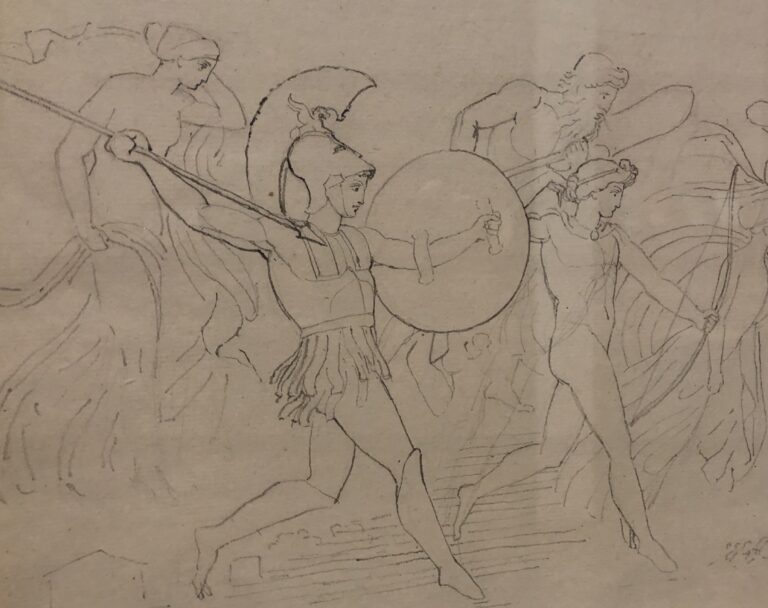As you enter the forecourt of the Royal Academy, you see them. A row of artistic titans, carved in stone, peer down from their alcoves in the higher half of the gallery’s façade. Thanks to the name plaques, they’re easily identified. You can see Pheidias, the genius of the Parthenon; Leonardo and Raphael; Sir Christopher Wren. And then there’s… John Flaxman.
Who? That’s a completely legitimate question. If these guys are, so to speak, the Avengers of art history, then Flaxman is the equivalent of Hawkeye. Hell, maybe he’s Agent Coulson. Even on his plinth, he has a mildly apologetic air. Under a bald pate, his hair hangs down in curly curtains. His hand, clutching a chisel, crosses his chest self-deprecatingly.
Yet there’s a case to be made that — while being a ‘very considerable figure as a sculptor’, as the art historian and Flaxman expert David Bindman assured me on the telephone — Flaxman has also had a huge influence as a draughtsman. Not least because he is the visual missing link between superhero movies and Homer.
You can see the evidence for this unlikely sounding claim in a small but excellent free exhibition currently showing at the RA. It’s devoted to drawings from the gallery’s vaults, which the English artist executed in Rome in the 1790s as part of a commission for engravings of scenes from Homer’s Iliad and Odyssey. Published as books, they made Flaxman famous across Europe. Goethe declared him ‘the idol of all dilettante’. Schlegel was amazed that ‘so much soul can dwell in a few delicate lines’. For Romney, his elegant etchings looked ‘as if they had been made in the age when Homer wrote’.
Which begs the question: how would he know? Neoclassicism was a dubious 18th-century movement, based on a handful of misapprehensions about classical culture. Homer didn’t write; sculptures weren’t white. What can’t be doubted, though, is that Flaxman’s stab at classical simplicity was an inadvertent proto-modernism. Inspired by Greek vase paintings, he pioneered the use of pure outline to create original narrative compositions. This was the foundation of the 19th-century comic strip, which led ultimately to DC’s Superman, Marvel’s Captain America, et al.
Homer (as illustrated by Flaxman) and superhero stories have more in common than clear, confident lines. Both present powerful heroes duking it out in jaw-dropping infinity wars. Both depend on fictional universes, with multiple warriors who can be assembled for mega- narratives. And the lurches in this long evolution have all occurred in times of crisis, when heroism offers an additional appeal: in the post-Mycenaean dark ages, Homer; after the French Revolution, Flaxman; superheroes drawn during the second world war; filmed ones post-9/11.
Drop in on the RA show and the classical authenticity is less obvious than the Marvel-esque quality of the work. The dynamic portrayal of ‘The Gods Descending to Battle’ could almost be a poster for an Avengers movie. In ‘Hector’s Body Dragged at the Car of Achilles’, the vengeful Achilles is turned away, unknowable: a very cinematic touch.
That’s not to say the drawings don’t have limitations. Compare the oddly static ‘Achilles Contending with the Rivers’ with the battle against a roiling, campanile-trashing water monster in this year’s Spider-Man: Far From Home, and Flaxman comes off badly. He was, by many accounts, a boring man. His lectures as the RA’s professor of sculpture were a drag. ‘Farewell friends, farewell wine, farewell wit,’ declared the painter Henry Fuseli, as he left a dinner party to attend the first of them. William Blake, who had been friends with Flaxman, later fell out with him, and wrote a scathing couplet describing him as thick: ‘I mock thee not, though I by thee am Mockèd/ Thou call’st me Madman, but I call thee Blockhead.’
In a lot of ways, it seems Flaxman was the anti-Blake: an untormented talent who enjoyed general acclaim. He may not deserve our pity, but he was centuries ahead of his time. Martin Scorsese says superhero movies aren’t cinema, and Flaxman, we feel, isn’t Homer. This doesn’t make either unworthy of love. Anyone who disagrees should rewatch Iron Man, say, The Dark Knight, or Thor: Ragnarok before weighing in to the debate — and see the Flaxman show before it ends in January.

